
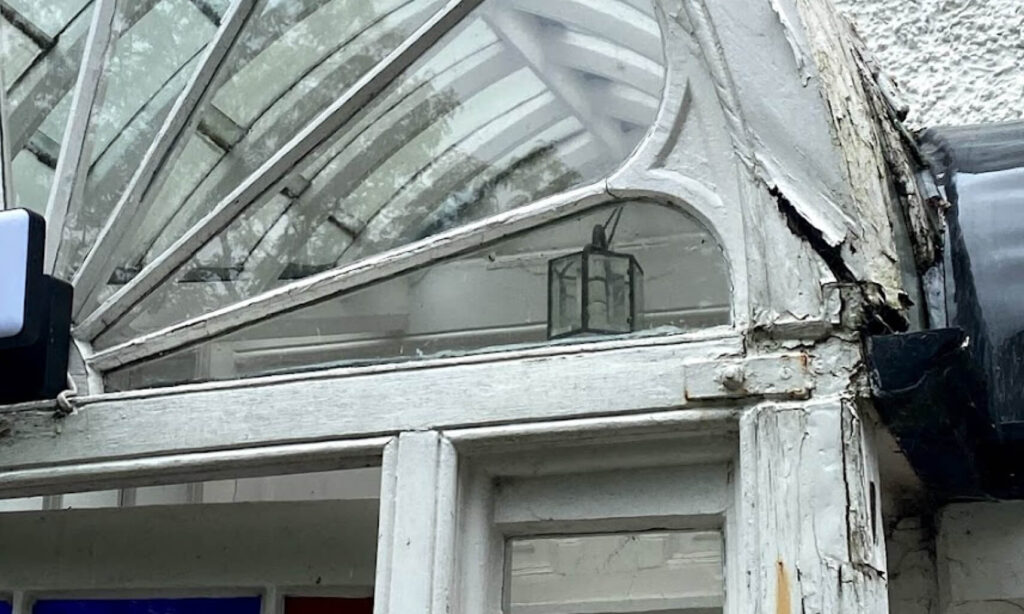
Rotten wooden window frames are extremely common in older homes. Rot can develop in wooden frames for a lot of reasons. We’ll explore the most common reason for rot in just a moment. Rot is caused by a type of fungus.
When any wood is left exposed to the elements, either without paint or the proper treatment. Rot can form, and it basically eats the wood.
However, there are ways of treating the rot in your wooden windows. In fact, there are even simple DIY methods you could use to solve issues with rotten windows. As long as you only have minor rot in your frames. Let’s take a look at rot and how to spot it in your frames. After this, we will explore what you can do to solve it, shall we?
Firstly, you should inspect the paintwork and any exposed surfaces of the frame for any discolouration or flaking. Whilst these visible signs don’t necessarily mean that rot is present. These areas are vulnerable points for wood rot to enter if not properly sealed or treated.
Therefore, it is wise to take a closer look at these spots when assessing the extent of damage to your window frame.
For further investigation of potential rot in your wooden window frame, you can check for soft spots by pressing down. On each section, lightly press with a small tool such as a screwdriver or even a finger. Healthy and solid wood will not give way under pressure. However, rotting wood will depress easily – this indicates that the wood has deteriorated within and requires repair or replacement.
Areas, where decorative elements such as moulding intersect with other sections are especially susceptible to rot. As they can be difficult to reach during routine maintenance and cleaning.
Another good indication of rot in your wooden window frame is water stains around frames or wet patches below them. This kind of moisture intrusion often signals advanced decay, which necessitates an urgent response from homeowners to prevent further deterioration.
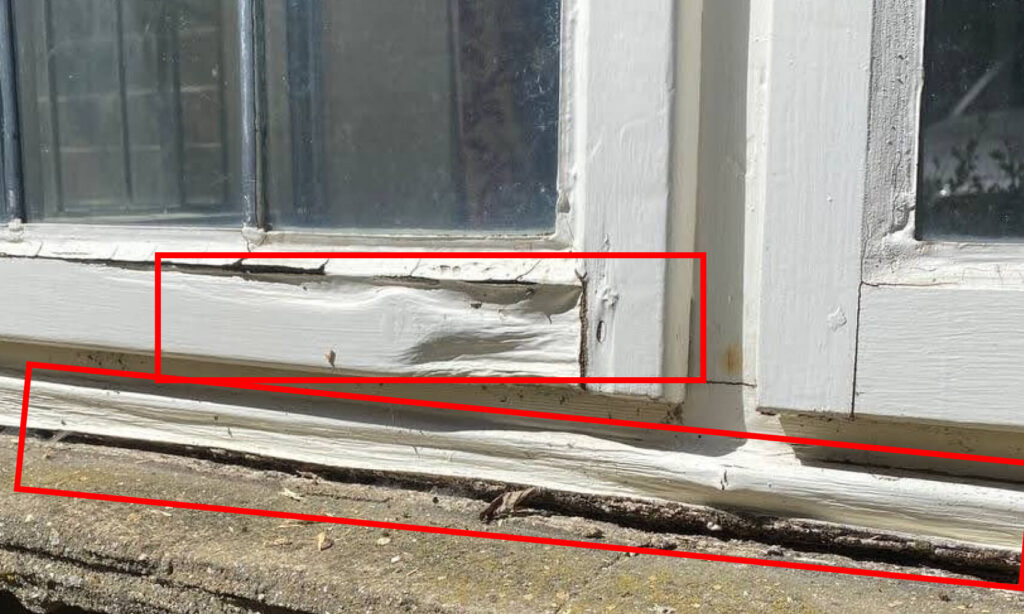
Check your wooden windows carefully – especially in the common problem areas. Look for softness, crumbling paint, or any signs of swelling.
You see, most wooden windows in the UK are made of dense hardwood, so there shouldn’t be any softness or brittleness in healthy wood. You should check common problem areas too. The bottom corners of the window frame, the sill and the lower strip along the bottom, even if the paint looks to be intact.
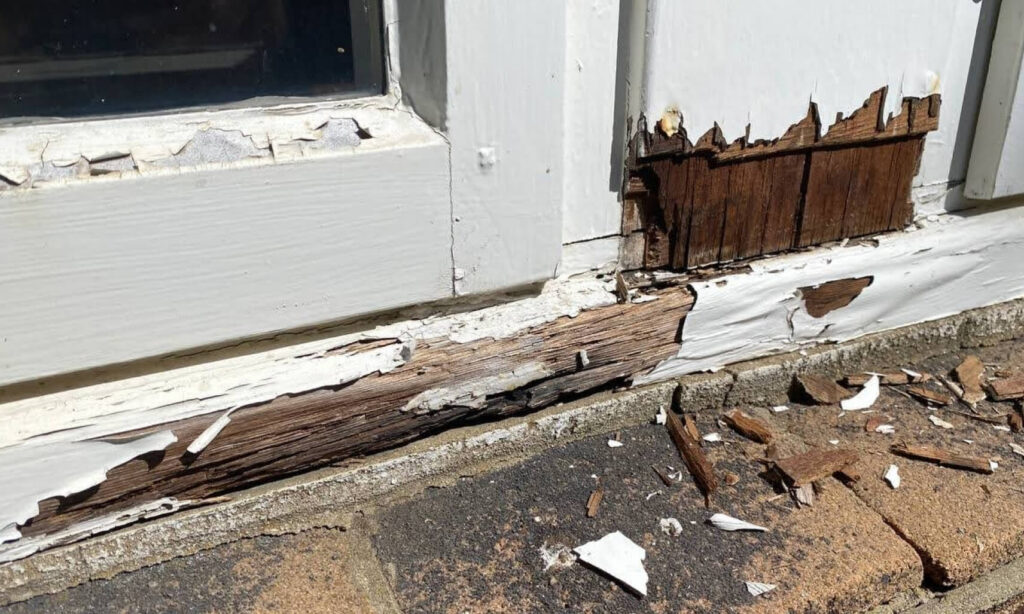

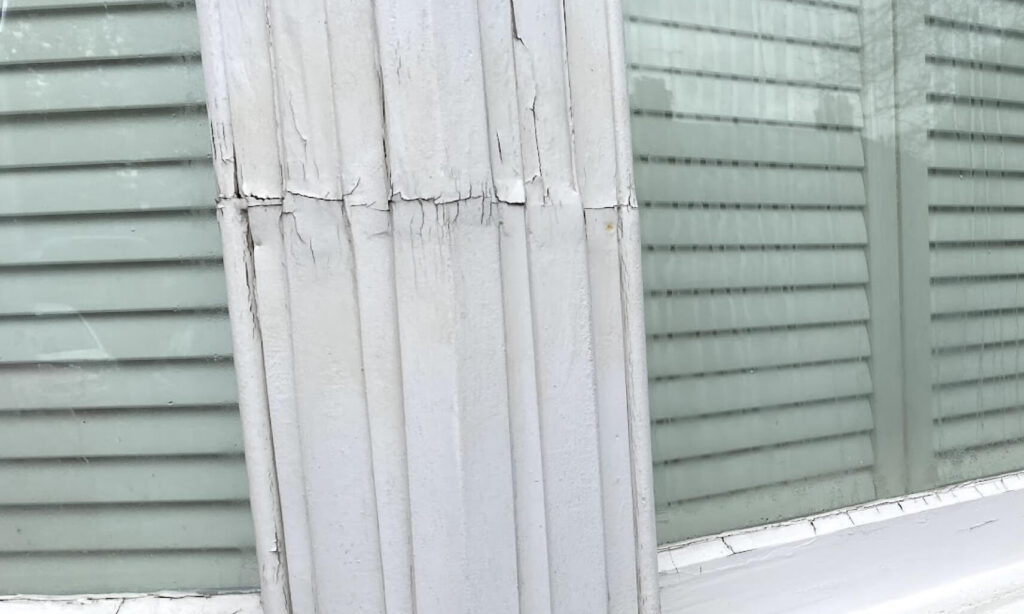
Take your time and give the timber a really good going over. You can even use a chisel to test suspect areas. If you notice any wood that isn’t solid, this is a sign of rot.
Rot occurs due to exposure to water. Rot absolutely loves damp conditions, and so the longer the wood is exposed to severe weather, the bigger risk of a big problem.

If your wooden windows have been in your home for hundreds of years, they can also be very dry. So, once they are exposed to water (via cracked or peeling paint), they will try and do what wood does, soak up the water, which will create rot.
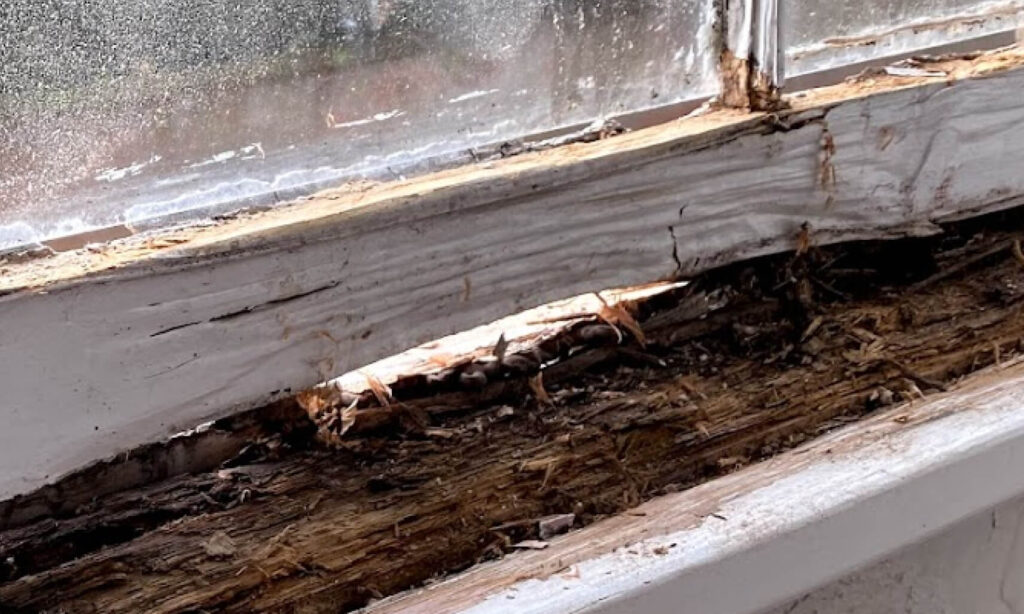
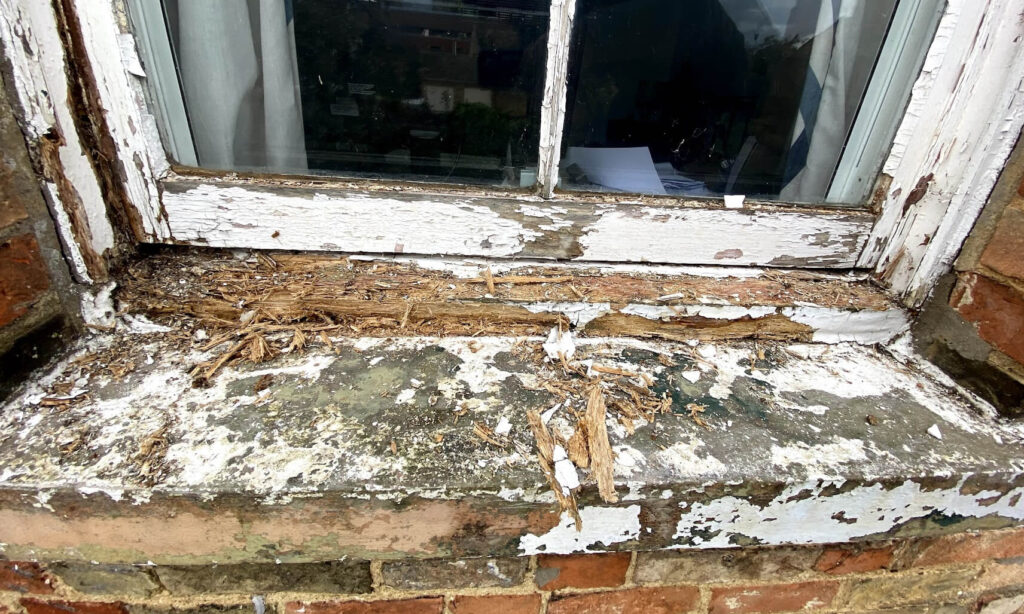

Every piece of timber has a moisture content, which fluctuates depending on the humidity and the seasons. Even the wood in your home is affected by humidity.
In England, exterior wood, including timber frame windows, sits at between 9% and 14% moisture content most of the year as long as it’s protected from moisture getting in.
If the wood isn’t protected, the moisture content can rise. If it rises to over 20%, this creates the perfect conditions for dry rot to grow.
Too much moisture content in wood can also create warping and cracking as the timber dries out. So, for wooden window frames and other exterior wood, it must stay within 9% and 14% moisture content.
40-60% moisture content in timber window frames creates ideal conditions for wet rot to develop and grow into a serious problem.
When it comes to working on your window frames, it is important to make sure the wood is dry enough. This can often be hard to tell with the naked eye, but luckily you can use a wood moisture meter to get an exact reading.
When humidity is high, such as after it rains or snows, moisture can still be present in the air even after everything looks and feels dry. If the paint is applied to windows without ensuring there’s no excess moisture in the wood, it can lead not only to rot but also to the bubbling of the paint.
Overall, using a wood moisture meter before painting window frames not only saves time and frustration but also helps promote lasting results.

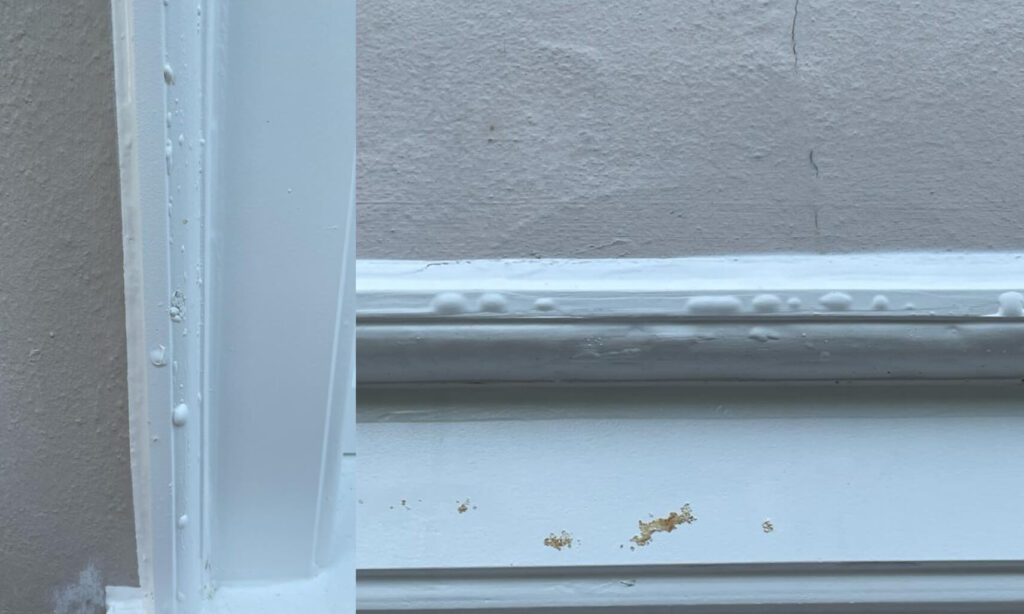
If the moisture content of the frames is over 17%, this can ruin the paintwork as the water tries to escape the frame. So, a wood moisture meter is really handy when doing anything with wood, particularly when you are trying to protect it from moisture.
Knowing that the wood is stable before you start is a must.
Windows are at a big risk of getting rot, as the fungus preys on the natural character of the wood. Never fear, though; there are some solutions to rot in wood.
There are plenty of solutions to rotting wood in window frames.
The key is identifying which method of treating wooden window rot is right for you. This comes down to budget, time and expectation. As well as the maintenance cycle you would like to achieve (some methods require more care than others).

Some of these rot treatment methods work fantastically well on frames with a small amount of rot present. While others are better suited to extremely rotten windows. Some methods are much cheaper than others but will not protect your timber windows from rot for a long time.
Some methods also require an extensive range of tooling and joinery skills, while others can be performed by savvy DIYers.
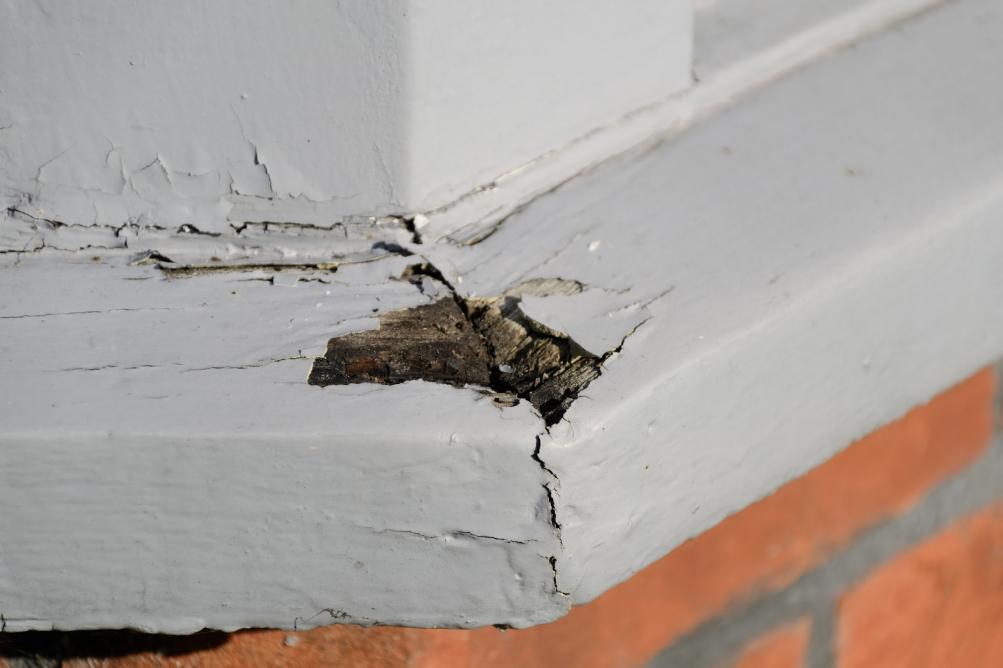
There are certain wood treatments available that work very well on rotting wood. These treatments work by killing the fungus and penetrating into the wood, and making it solid again. It cannot replace any wood that is very far gone, but you can use a good quality wood filler to fill any gaps.
There’s a good chance of reversing the wet rot in the timber. This requires a special wood treatment that is available at most DIY stores and online. These treatments work fantastically on wet rot as long as the source of water has been found and fixed.
A pro tip to use with this wet rot treatment is to treat all of the timber, not just the areas that you can see are affected by the rot. That way, you can be sure that the rot has been reversed, and you won’t run into trouble moving forward.

There are also epoxy wood fillers treatments available for wood rot. It is best to buy a rot repair kit as it has a couple of epoxies in it that are perfect for the job.
The first epoxy is thin, penetrating one that is designed to go deep inside the wood and hold everything together. It kills the fungus and ensures that the wood is solid again. The second epoxy is then used as an epoxy filler.
Epoxy fillers are excellent for keeping water out of wood and providing a solid surface ready for paint.
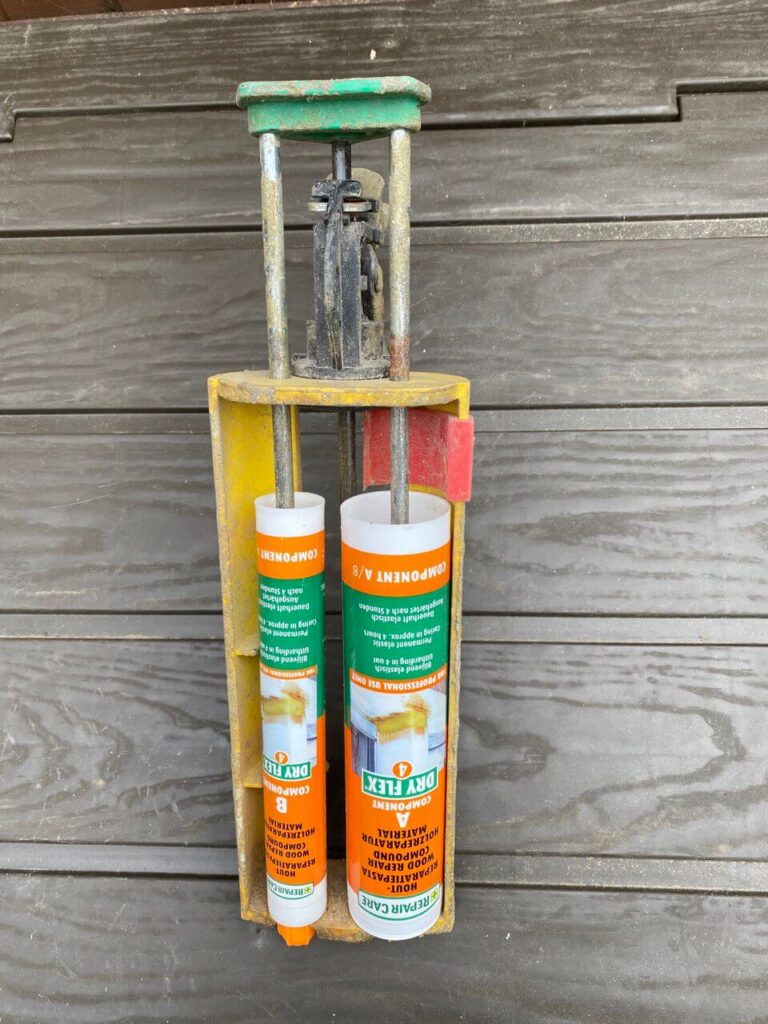
If there are large areas of the window frame that are affected by rot, you could consider replacing the whole frame or doing spliced repairs. When our team repairs sash windows, we replace rotten parts of the window with Accoya wood or Tricoya MDF.
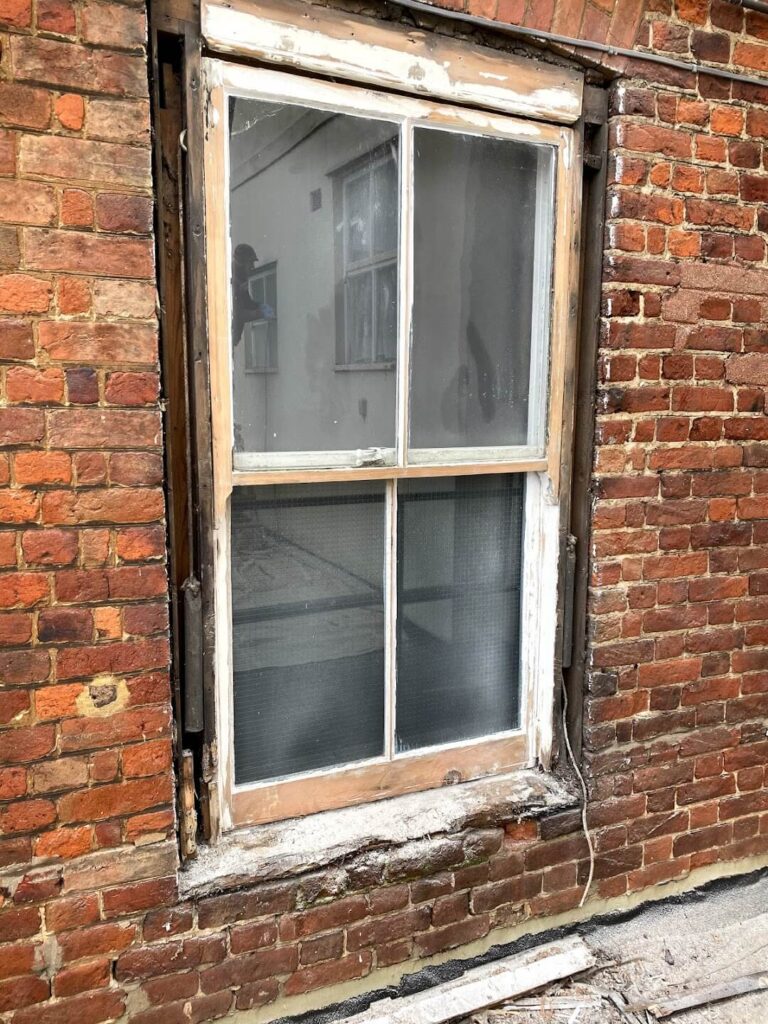
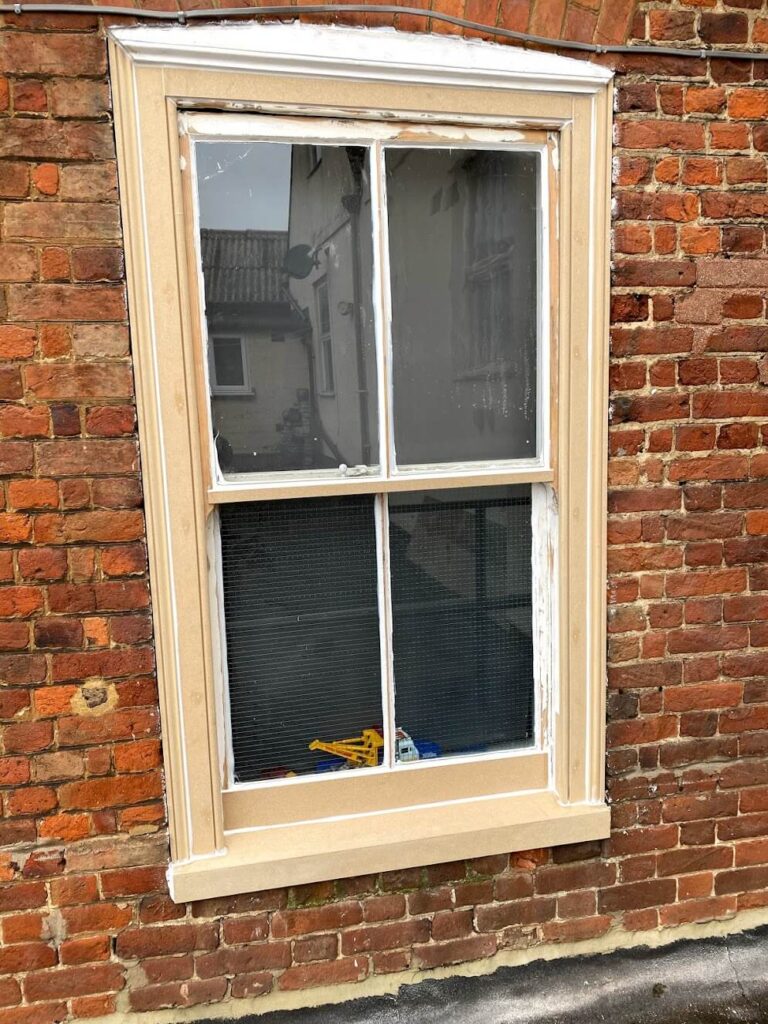
Here is the list of timber window parts that can be easily matched and replaced cost-effectively. You will probably need to order these parts from a local joinery workshop.
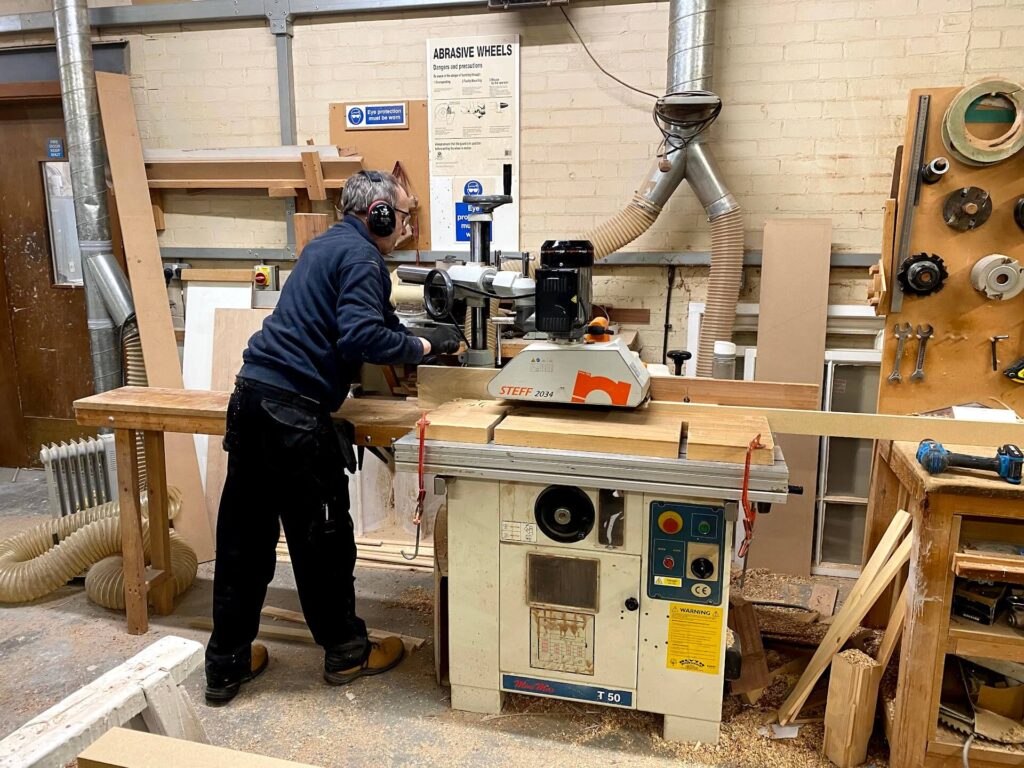
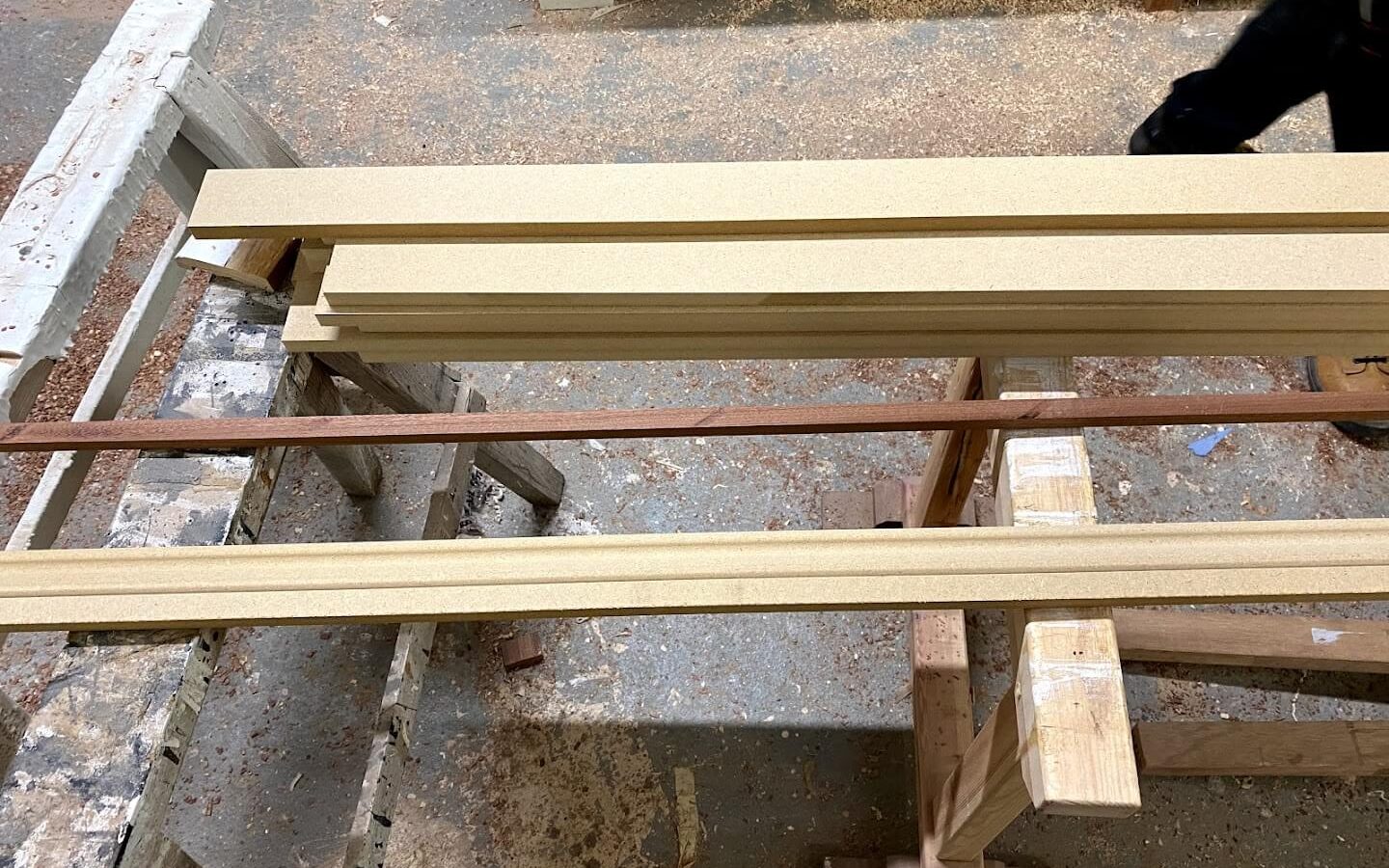
This is a tricky job and one that requires extensive tooling.
However, it is the most rewarding way of fixing wooden window frames. This type of repair will last a lot longer than repairs with wood fillers or spliced repairs.
Plus, it will look great for years, and you’ll have the pleasure of learning some new woodworking skills or enhancing the skills you already have.
If you are just looking to replace a single rotten window sill. Sash window companies usually charge around £250 for the job. For more extensive restoration and repair work that includes splicing and draught-proofing, expect to pay around £700 per sash window, not including painting.
Either way, taking the time to make sure your windows are properly taken care of. This can help save money in the long run, and will ensure your frames last for years to come.
Our wooden window restoration company has different approaches to sash window restoration; you can read about our sash window refurbishment prices here.
Splicing or scarfing in is an effective way to repair your rotten window frames. This process involves cutting out the rotten wood and replacing it with fresh timber that has been shaped to match existing profiles for maximum strength.
This method of repairing window frames requires some skill and experience but can be a great way to restore them to their original condition both in terms of looks and durability.
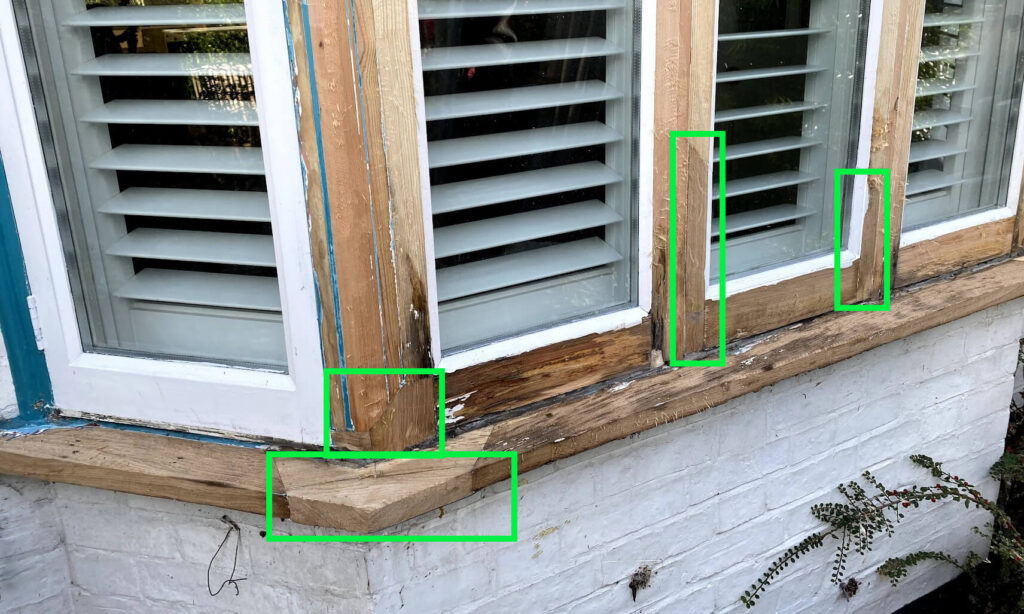
While excessive trimming of the timber should be avoided, you must remove all of the rotten wood as you can. You should also work with any deformation in the existing frame as well. That way, your new splice won’t affect the operation of the window.
Spliced repairs must also keep water directed to the outside of the window. This means that your repair must not enter a joint already present in the window, which may lead to moisture entering the joint and causing more issues.
If available, it is always best to use the same timber as the window frame already has. If you can’t find the timber locally, you can try online or try and match the timber as close as possible with a good-quality wood with similar moisture content (your local timber yard will be able to help you with this).
You should be selective with your timber, though. Also, avoid knot shakes or sapwood if at all possible. These are weaknesses in the wood that can cause further issues down the road.
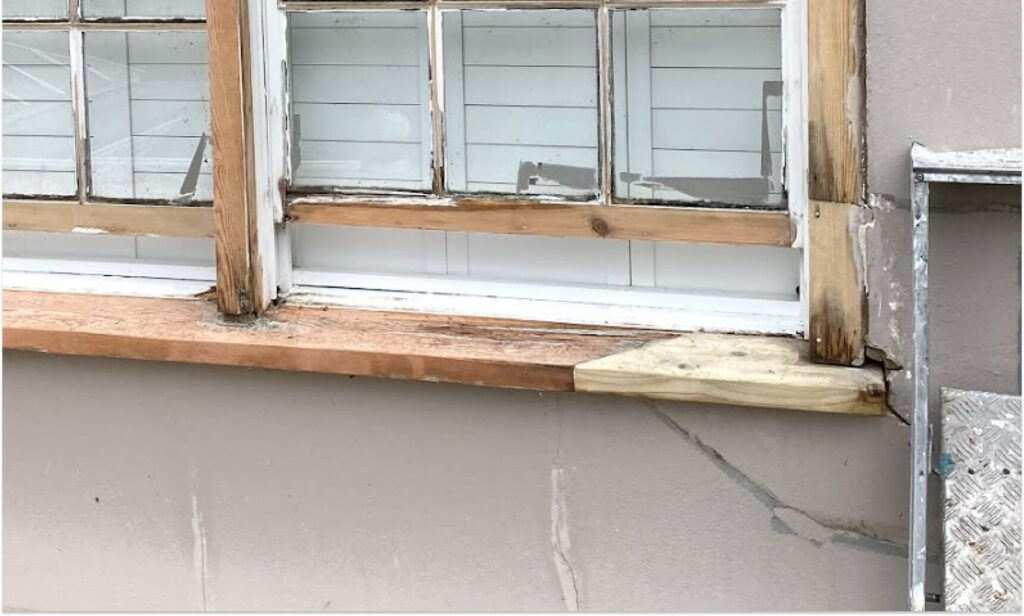
If you plan on doing any perseveration to the existing timber, the ideal time to do this is after the rotten wood removal. It is well worth using a dry rot treatment on your rotten wooden window frames while doing splice repairs, though, as it can make sure that the existing timber is nice and stable.
To remove the rotten wood, you can use hand tools like a handsaw, chisels, a hammer and a plane. You can also use power tools like routers and make jigs and things like that. The method you use to splice repair your windows greatly depends on your current skill level with tools.
After glueing splice repair parts you can then finalise the shape according to the existing window frame with sanding. Give them a finish sanding and then paint and prime the rest of the window. If there are any gaps in your splice repairs, though, do make sure to fill them with an exterior-grade wood filler prior to priming and painting.
As the last option, instead of repairing your rotten wooden window frames, you can replace the whole window. Replacing the window isn’t an easy job. We certainly wouldn’t recommend a DIYer tries to change a wooden frame, as they are tricky to do, and windows fitters have to be FENCA or Certass registered.
If the person who fits your new window can not give you certification upon the window replacement, this can cause trouble. It might even lead to delays when selling your home, as your new windows must comply with building regulations.
Dry rot is a type of fungus. It decays the wood when the wood becomes too wet. It is the most serious form of wood rot and occurs when there is over 20% moisture content in wood. Dry rot is extremely destructive, and it can spread across the brickwork and masonry of your home and attack other wood too, including structural timbers and flooring. If left untreated, dry rot can damage the structural integrity of your home. The reason that dry rot is so dangerous is that it eats the wood but also draws the moisture away from the wood. This causes any remaining wood to be very brittle.
Dry rot starts as an airborne fungus. When this fungus comes into contact with damp wood, these spores will germinate. As the spores grow, you will begin to see a thick cotton-like substance that covers the timber.
Dry rot needs damp conditions in order to thrive. So, if your window frames are not protected properly with a good layer of paint, they can get wet, and if dry rot spores land on this damp timber, it will cause dry rot.
Yes, you can repair a rotting frame, but it isn’t easy, and it isn’t always recommended. If there is too much rot in the window frame, it will make the frame very unstable, no matter how much filler you add.
You can, of course, replace sections of heavily rotted wood with new wood, but this isn’t easy. Unless you are a trained joiner who knows how to use power tools and cut joinery, you may struggle to replace the rotting areas of the frame.
Certainly, you can repair a window frame with minor rot, though. You can use penetrating wood treatments and epoxy to rebuild the wood and fill up any missing areas. You can then sand and repaint the window frame. If you do have a lot of windows that are showing signs of rot, though, it may be worth giving us a call.
Yes, absolutely. One of the best things about wooden window frames is that they are almost endlessly repairable. Even if one part of the frame is beyond fixing, you can simply cut a fresh piece of wood and replace it.
Fixing a window isn’t the easiest thing to do. While a professional bench joiner could make light work of all of the joints and finishing process with hand tools, even an avid DIYer could struggle. If your windows need fixing, it’s worth considering getting professional help. It’ll save you a lot of time!
The best way to stop windows from rotting is regular maintenance and painting them every 7 years or so. This will bring the window frames back to their original condition, which is awesome.
However, it also stops the older paint from failing and allowing moisture to get into the wood and start the rotting process. Of course, if you notice any areas of concern in your windows before this, do take action. If you catch problem areas quickly. You can sometimes repaint without needing to treat for rot. Still, do check for any signs of rot before you paint!
If you’ve just moved into a property with wooden windows and aren’t sure when they were painted, it is worth giving them a coat of paint now. You can also remove the older paint and check for early signs of rot, then prime and paint with good quality products to eliminate rot.